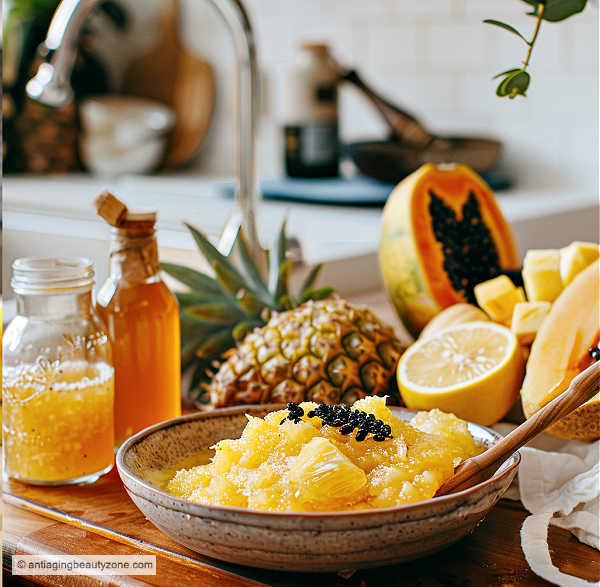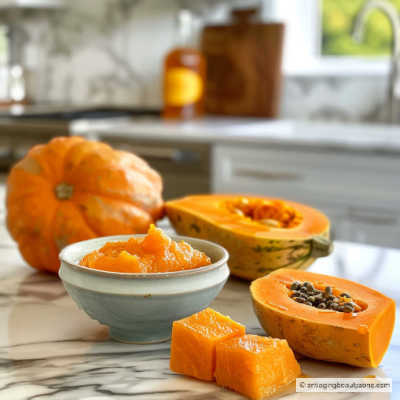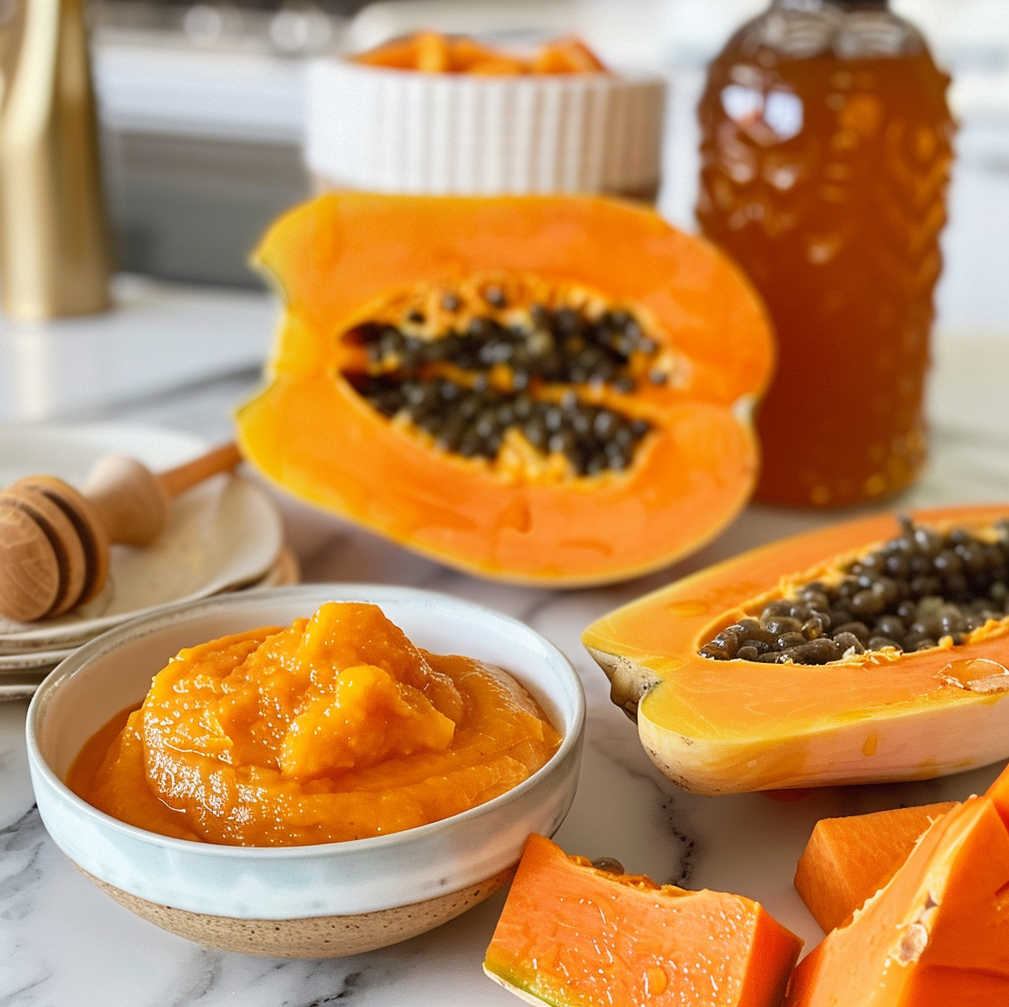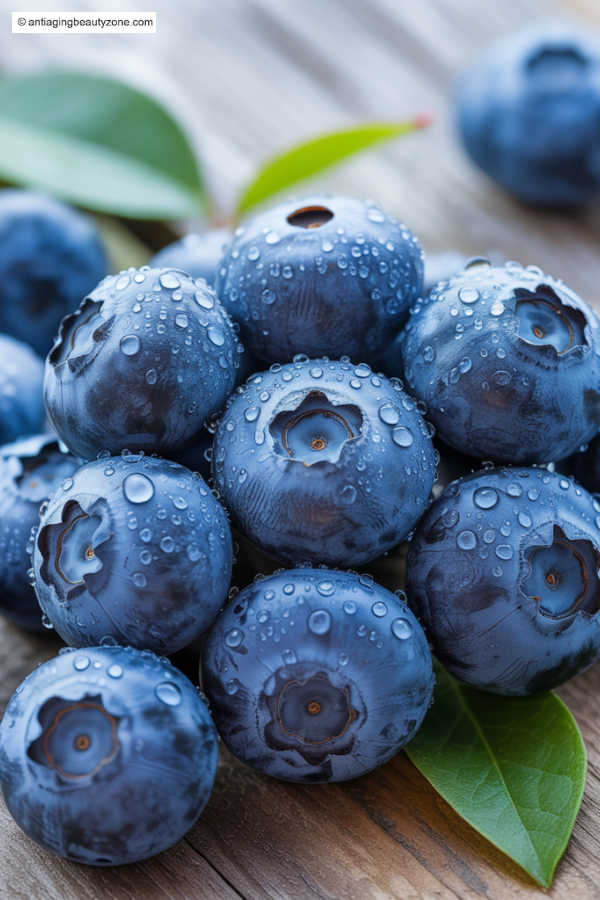As an Amazon Associate, I earn from qualifying purchases and other affiliate links. I only recommend products I’ve tried or researched.
- Home
- Skincare Guide
- Homemade Skincare
- Enzyme Recipes
Enzyme Face Mask Recipes For Glowing Skin
Homemade enzyme face masks offer a budget-friendly solution for glowing skin! These enzyme mask recipes are simple to make at home—surprisingly powerful yet gentle.
Here’s the fun part: Enzyme masks can do what retinol can’t—give you that same-day glow without the dryness, flaking, or irritation.
While retinol works deeper and takes time, enzymes melt away dull surface cells instantly, leaving your face smooth, bright, and fresh after just one use.
See all my DIY scrubs and masks next...

Quick Enzyme Mask Recipes (At-a-Glance)
Short on time? Try these simple mixes.
Pumpkin Enzyme Mask Recipe
- 2 tbsp pumpkin purée or mashed pumpkin meat
- 1 tsp honey
- Pinch cinnamon (optional; skip if sensitive)
Steps: Apply thin layer. Leave 5–10 minutes. Rinse. Moisturize.
Note: For best results, use fresh pumpkin purée or cooked pumpkin—not leftover carved pumpkins. Once a pumpkin’s been sitting out (especially if it’s been carved), it can collect bacteria and mold that aren’t safe for your skin.
Papaya Enzyme Mask at Home
- 2 tbsp ripe papaya, mashed
- 1 tsp honey
- 1 tsp yogurt
Steps: Apply to clean skin. Leave 5–10 minutes. Rinse.
Tip: If you’re sensitive, start with 5 minutes only.
Enzyme for skincare

Enzymes are natural exfoliators found in fruits (like pineapple, papaya, and strawberries). These powerful proteins gently remove dead skin cells, revealing fresh, glowing skin underneath.
Unlike granulated scrubs (which I love), enzyme peels and masks are kinder to your skin, making them great for all skin types.
According to board-certified dermatologist and founder of Surface Deep, Dr. Zalka, enzymes work similarly to alpha hydroxy acids but are gentler on some skin types. They make your skin look smoother and can help with pigmentation and breakouts.
Benefits of Homemade Enzyme Masks
Board-certified New York City dermatologist Dr. Dendy Engelman tells Cosmopolitan magazine, that face masks are beneficial for targeting and controlling specific skincare needs, such as hydration.
While they're not a standalone solution, they do enhance your skincare routine by providing targeted benefits.
Why should you try enzyme masks? Here are some awesome benefits:
- Gentle Exfoliation: They remove dead skin cells without causing irritation.
- Brightening: Enzymes help even out your skin tone and reduce dark spots.
- Anti-Aging: Regular use can boost collagen, making fine lines and wrinkles less noticeable.
- Hydration: Many enzyme masks have hydrating ingredients that leave your skin feeling soft and smooth.
DIY enzyme mask recipes at home

Here are some recipes you can try at home. These basic recipes have worked for me, but feel free to tweak them to suit your complexion and sensitivity.
1. Pineapple
Why it works: Bromelain helps lift dull, dead cells. Skin looks brighter
Pineapple Enzyme Peel at Home:
- 1/4 cup fresh pineapple, pureed
- 1 tablespoon coconut milk
- 1 teaspoon honey
Steps: Apply a thin layer. Leave 5–10 minutes. Rinse well. Moisturize.
Patch test first. Tingling is normal. Stinging means rinse.
2. Pumpkin

Why it works: Enzymes + gentle AHAs smooth skin and boost glow.
Pumpkin Enzyme Mask Recipe
- 2 tbsp pumpkin purée
- 1 tsp honey
- Pinch cinnamon (optional; skip if sensitive)
Steps: Mix smooth. Apply to clean skin. Leave 5–10 minutes. Rinse. Moisturize.
Sensitive? Skip cinnamon. Start with 5 minutes.
3. Papaya

Why it works: Papain is gentle. Great first enzyme mask at home.
Papaya Enzyme Mask at Home
- 2 tbsp ripe papaya, mashed
- 1 tsp honey
- 1 tsp yogurt (optional comfort)
Steps: Apply thin layer. Avoid eyes and lips. Wait 5–10 minutes. Rinse. Hydrate.
Want a soft cleanser too? See my gentle exfoliation tips.
4. Berries

Why it works: Antioxidants calm and brighten. Enzymes here are mild.
Antioxidant Face Mask (Homemade, blueberry)
- 1/4 cup mashed blueberries
- 1 tbsp honey
- 1 tsp lemon juice (optional; skip if sensitive)
Steps: Apply for 10 minutes. Rinse well. Moisturize. Use SPF daily.”
5. Peaches
Peachy Keen Clean
Peaches contain natural enzymes that gently exfoliate, perfect for sensitive skin.
Peachy Enzyme Mask:
- 1/4 cup mashed ripe peach
- 1 tablespoon Greek yogurt
- 1 teaspoon honey
Combine ingredients, apply to face. Leave 5–10 minutes. Rinse. Moisturize.
6. Cocoa powder
Cocoa Comfort for Sensitive Skin
While cocoa isn’t enzyme-rich, it’s packed with antioxidants. Mixing it with enzyme-rich honey and fruit creates a gentle, nourishing treatment.
Cocoa-Honey Enzyme Blend:
- 1 tablespoon cocoa powder
- 1 tablespoon honey
- 1 teaspoon mashed papaya or other fruit mentioned here
Mix ingredients. Apply a thin layer. Leave 10 minutes. Rinse well. Moisturize.
Mask tips

For best results, follow these tips:
- Always patch test new ingredients
- Apply to clean, dry skin
- Use gentle, circular motions when applying
- Don't leave treatments on longer than recommended
- Follow up with a moisturizer
- Wrap a towel around your shoulders to protect against stains.
See more facial mask dos & don’ts and different types of facial masks.
Storage: Due to loss of potency and possible bacterial growth, use enzyme face masks immediately. Do not store.
Ingredient recommendations
Fresh ingredients are always the best as they offer the highest enzyme content and benefits. If fresh isn't available, frozen versions (fully thawed) are the next best alternative.
Canned fruits are not recommended due to enzyme loss and potential additives during processing.
For cocoa, raw or unsweetened cocoa powder is preferable, while sweetened cocoa mixes should be avoided due to added sugars and other ingredients.
Potential side effects
While enzyme treatments are generally gentle, some people may experience irritation. If you notice redness, itching, or burning, rinse off immediately.
Those with extremely sensitive skin or active skin conditions should consult a dermatologist before trying new treatments.
See my FAQ below for more
Enzyme Mask vs. AHA/BHA Peel
Both exfoliate, but the feel is different. Enzymes are usually gentler.
AHAs and BHAs are acids. They can sting more and penetrate faster.
Use one method per session. Alternate nights to protect your skin barrier.
- Best for beginners: Enzyme masks at home, 5–10 minutes.
- Best for faster results: AHAs/BHAs, used with care.
- Always: Moisturize after. Wear sunscreen daily.
Check out my step-by-step on lactic vs glycolic acid — and when to use both
FAQ
Question: What is an enzyme face mask?
Question: What is an enzyme face mask?
Answer: A mask that uses fruit enzymes (like papain or bromelain) to dissolve dead skin cells for gentle exfoliation and glow.
Question: Are enzyme masks good for sensitive skin?
Question: Are enzyme masks good for sensitive skin?
Answer: Often yes—enzymes are milder than many acids, but always patch test and shorten the time if you’re reactive.
Question: How often can I use an enzyme mask at home?
Question: How often can I use an enzyme mask at home?
Answer: 1–2× weekly for most; start at 1× and build up based on tolerance.
Question: How long do I leave an enzyme mask at home on?
Question: How long do I leave an enzyme mask at home on?
Answer: 5–10 minutes is plenty; rinse sooner if you feel stinging or redness.
Question: Which fruits make the best enzyme mask recipe?
Question: Which fruits make the best enzyme mask recipe?
Answer: Papaya (papain), pineapple (bromelain), pumpkin (mixed enzymes + AHA), and berries (antioxidants with mild enzymatic action).
Question: Can I combine enzyme masks with AHAs/retinoids?
Question: Can I combine enzyme masks with AHAs/retinoids?
Answer: Not in the same session. Alternate nights to avoid irritation.
Question: Do enzyme masks help with dark spots?
Question: Do enzyme masks help with dark spots?
Answer: They can brighten by improving cell turnover; results are gradual and improve with consistent use + sunscreen. For more ideas, see my skin brightening tips page
Question: Can I store leftover homemade enzyme masks?
Question: Can I store leftover homemade enzyme masks?
Answer: No—use immediately. Fresh fruit mixes lose potency and can grow bacteria.
Question: Is cinnamon safe in enzyme masks?
Question: Is cinnamon safe in enzyme masks?
Answer: Cinnamon can be irritating; skip if you’re sensitive or reduce to a tiny pinch.
Takeaway
Enzyme-based homemade face masks offer a natural, gentle, and inexpensive way to get glowing skin.
By adding these DIY treatments to your skincare routine, you can enjoy the benefits of exfoliation, brightening, and anti-aging without harsh chemicals. It's a nice break from store-bought chemical laden products.
Remember, consistency is key, so make these masks a regular part of your DIY scrubs and masks beauty routine. You may also like my sugar face scrub recipes or pearl powder mask for more gentle, natural options.
Note: Since I use lactic acid and glycolic chemical peels often (about once a month), I try to add these homemade masks to my routine about 4 times a year. Once for each new season. However, it's important to find what works best for you.
Here's to your glowing skin journey!
Want More?
I share quick routines, beauty tweaks, and what’s working for me — straight to your inbox. Join the Club and get this free Cheek Shaper Video.
About the Author:
Linda Robison is a Facial Fitness Specialist and the founder of Anti-Aging Beauty Zone. With decades of hands-on experience, she shares practical, natural ways to lift and brighten mature skin—without expensive or invasive treatments.
Before you go ....
Please tap on the💙in the bottom right corner if you found this page helpful.
FOLLOW ME FOR MORE TIPS:
SHARE OR SAVE FOR LATER:


